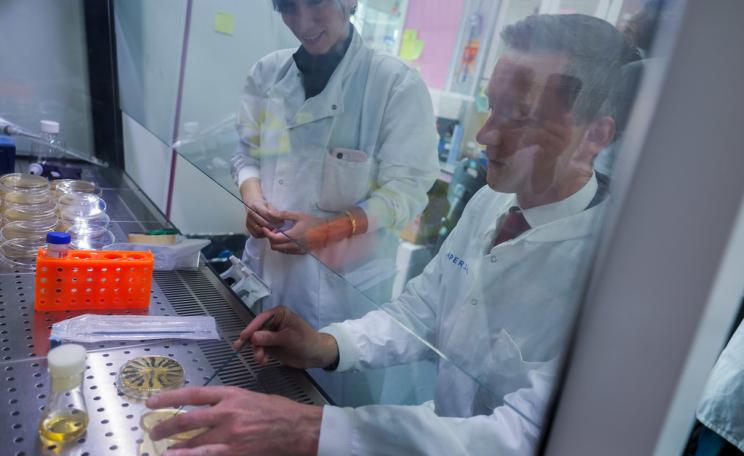.Wine lovers shouldn’t have to risk exposure to an array of hazardous pesticides when they fancy a tipple. The organic wine sector is flourishing.
The presence of harmful pesticide mixtures in wine has increased more than threefold since 2016, official statistics analysed by Pesticide Action Network UK (PAN UK) have revealed.
Findings from the testing programme conducted by the UK government indicate a significant rise in the percentage of wine with multiple pesticide residues, surging from 14 per cent in 2016 to 50 per cent in 2022.
The analysis of 72 wine samples in PAN UK's report reveals residues of 19 pesticides, nine of which are linked to cancer. A single wine sample was discovered to contain six different pesticides.
Excessive
Nick Mole, PAN UK’s policy officer, said: “This massive rise in ‘pesticide cocktails’ should be of grave concern because we know that chemicals can become more harmful when combined, and yet we continue to set safety limits for just one chemical at a time.
"Wine lovers shouldn’t have to risk exposure to an array of hazardous pesticides when they fancy a tipple. The organic wine sector is flourishing, proving that it is entirely possible to produce wine without relying on toxic chemicals.”
The excessive use of pesticides in the production of wine not only poses a threat to the health of consumers, but also endangers the wellbeing of individuals living and working in wine-producing regions.
In a study conducted in France in October, it was found that children living near vineyards had a higher likelihood of contracting leukemia. Additionally, a Canadian research revealed that individuals employed in the wine industry were at a higher risk of developing illnesses, attributed to their exposure to elevated levels of pesticides.
A French nationwide study published in the Environmental Research journal suggested that agricultural practices and pesticides used in vineyards could have been linked to the occurrence of Parkinson’s disease.
Dirty dozen
There seems to be a rising trend in the occurrence of pesticide combinations in the food consumed in Britain, according to PAN UK's findings. The total percentage of fruit and vegetables with residues from multiple pesticides has consistently stayed below 48 per cent but this year it unexpectedly spiked to an astonishing 53 per cent.
Mole added: “This year’s results show that, just like our rivers, much of our food is increasingly contaminated with pesticide cocktails. We have no idea what his ongoing exposure to tens – or even hundreds – of different chemicals is doing to our health over the long term.”
In a report by PAN UK and the Soil Association, it is highlighted that despite the prevalence of pesticide cocktails and the evidence pointing to their potentially greater harm compared to individual pesticides, the UK's regulatory system continues to assess the safety of each chemical independently. Safety evaluations for pesticide residues in our food are conducted based on the analysis of individual chemicals.
.Wine lovers shouldn’t have to risk exposure to an array of hazardous pesticides when they fancy a tipple. The organic wine sector is flourishing.
Today, PAN UK launched its yearly 'Dirty Dozen' list, identifying the fruit and vegetables with the highest likelihood of being contaminated by multiple pesticides.

Source: data presented based on PAN UK analysis of the UK Government’s Expert Committee on Pesticide Residues in Food (PRiF) four quarterly data spreadsheets for 2022.
Analysis
PAN UK's analysis revealed that among 134 different pesticide residues found in all produce, 50 per cent fall under the category of 'highly hazardous pesticides.' Furthermore, 45 of these are carcinogens, 25 act as endocrine disruptors, impacting hormone systems and leading to birth defects, developmental disorders, and infertility.
Additionally, 14 are considered developmental or reproductive toxins, affecting sexual function, fertility, and potentially causing miscarriages, while 10 are cholinesterase inhibitors capable of impairing the respiratory system.
“Rates of chronic diseases such as cancer and Parkinson’s are rising”, added Mole. “We urgently need to take a precautionary approach and do everything we can to tackle pesticides in our food chain. But the UK government’s key strategy on pesticides is almost six years late now, and their proposal to introduce pesticide reduction targets never happened.
“Our new environment secretary, Steve Barclay, must do better than his recent predecessors and finally make good on the government’s promise to better protect human health and the environment from pesticides.”
Ambition
Pesticides have to be approved by the Chemicals Regulation Directorate (CRD), and authorised by the Health and Safety Executive before they can be sold, distributed, stored or used in the UK.
The Department for Environment, Food and Rural Affairs (Defra) spokesperson said: “In Great Britain, we set strict limits on the pesticides residue levels that are allowed to remain in both food for consumers and feed for animals.
"These limits are set to protect public health and are set below the level considered to be safe for people to eat. The limits apply to both food produced in the UK and those imported from other countries.”
In 2018, the UK government committed in its 25 Year Environment Plan to decrease pesticide usage and reassess the UK National Action Plan for the Sustainable Use of Pesticides (NAP) by the year's end. However, the publication of the NAP is still pending.
“In line with Defra’s 25 Year Environment Plan, the forthcoming National Action Plan on the Sustainable Use of Pesticides (NAP) will see out our ambition to support pesticide users to maximize non-chemical control approaches. The NAP will be published in due course,” added the Defra spokesperson.
This Author
Monica Piccinini is a freelance writer, focused on environmental, health and human rights issues.







